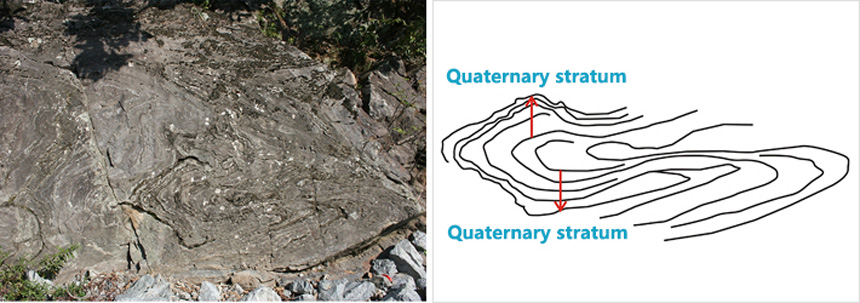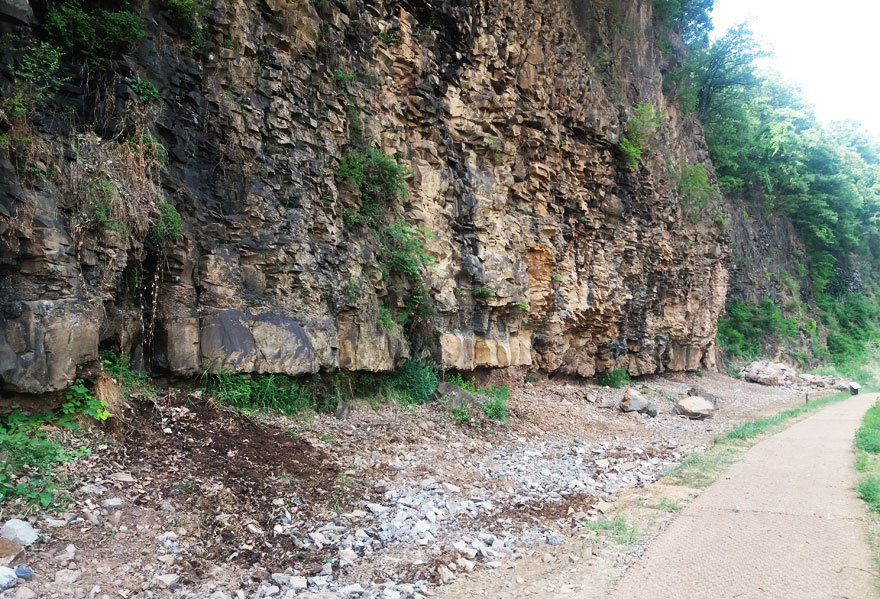Geosites
Eundaeri Sheeting Joint & Fold Structure
- Baekuiri Formation
- Jaein Falls
- Dongmakri Tuff
- Jwasangbawi Rock
- Jeongokri Paleolithic Site
- Chatancheon Columnar Joints
- Eundaeri Sheeting Joint & Fold Structure
- Dangposeong Fortress
- Imjingang Columnar Joints

Like Chatancheon Columnar Joint, Eundaeri Planticular Joint corresponds to a place made by lava that flowed backward along Chatancheon and hardened. But, Eundaeri Region is a geological attraction with very high scientific and educational value because horizontal joints not easily observed in Hantan River and Imjin River are observed. As lava is cooled, columnar joint and horizontal joint are made depending on the environment at that time and the cause of horizontal joint observed in Eundaeri Region is not revealed clearly yet so it can be said to be very important academically. In Eundaeri Region, Baekuiri Layer is well developed at the bottom including horizontal joints and imbrication in which pebbles show the form of fish scales in the direction of water flowing is observed and pillow lava and clinkers are observed, enabling you to observe various geological phenomena. Rocks underlying Eundaeri Region correspond to Misan Layer of the Paleozoic and are known to be metamorphic rocks of sedimentary origin.
Rocks were made about 1.4 billion years ago and calcareous and siliceous deposits were repeated. That is, the calcareous layer which is estimated to be biogenic and silicic of clastic origin (sand and clay) were piled up repeatedly and then, transformed by metamorphism by crustal movements but they are called metamorphic rocks of sedimentary origin because stratification bedding at the time of deposition is preserved.Looking at the surface of rocks, the degree of depth is observed differently and the calcareous part is dug deep because it is weak to weathering and siliceous part seems sticking out because it is relative resistant to weathering.
Also, it shows the fold structure showing the shape of the bent surface of rocks and fold is the structure that horizontally sedimentary strata show a curved cross-section like a wave by lateral pressure and a kind of ductile deformation result accompanied by high temperature and compressive stress. Fold structure can be easily seen in rocks with bedding plane and be divided into various forms depending on inclination of fold axis, inclination of fold axial surface, angle between the wings etc.
 Eundae-ri Planticular Joint and Fold Structure
Eundae-ri Planticular Joint and Fold Structure
How old is basalt?
The absolute age of basalt distributed in Hantan River is the subject of interest of many people but the research topic not resolved completely until recently. According to studies to date, however, the age of the oldest basalt is known to be about 510,000-550,000 and the period when lava flowed the most recently to be approximately 120,000-150,000. Looking at the results of measuring the age of basalt relatively recently, the upper age under Jeongok Eundaeri Jang Jin Bridge and that in the lower lave were reported to be about 150,000 years and 510,000 years, respectively and Kim Jeong-min et al. in 2014 took samples at the top, center, bottom of basalt cliffs in Eundaeri Planticular Joint and reported 40Ar-39Ar age of 0.12±0.01, 0.48±0.01, 0.54±0.07Ma, respectively and raised the possibility of intermittent volcanic eruptions. But until now, discussion on the age of basalt continues and it is necessary to reveal the exact age of basalt through further research in the future. Putting ages so far together, however, the age of the lowermost basalt was found to be 510,000~550,000 years, that of basalt with the second thickest columnar joint to be about 480,000 years and that of top basalt to be about 120,000~150,000 years.
Result of basalt age dating until now
| Age | Researcher | Age dating method |
|---|---|---|
| 138.4±5.7ka, 136.5±5.4ka | ark Gye-heon et al, 1996 | whole rock K-Ar |
| 0.27~0.1Ma | choi, 1982 | whole rock K-Ar |
| 540ka | Lee Dong-nyeong et al, 1995 | whole rock K-Ar |
| Corresponding to Brunhes Chron after 780ka | Kim Gyu-han et al, 1984, Lee Yun-su et al, 2001 | paleomagnetism |
| 0.27Ma | Kim Bok-cheol et al, 2004 | arithmetic average of the above age |
| 0.15Ma and 0.51Ma | Ryu et al., 2001 | feldspar crystals K-Ar |
| 0.12±0.01, 0.48±0.01, 0.54±0.07Ma | Kim, Jung–min et al, 2014 | 40Ar-39Ar |
 Source : Hantan River-Imjin River Geopark application
Source : Hantan River-Imjin River Geopark application
